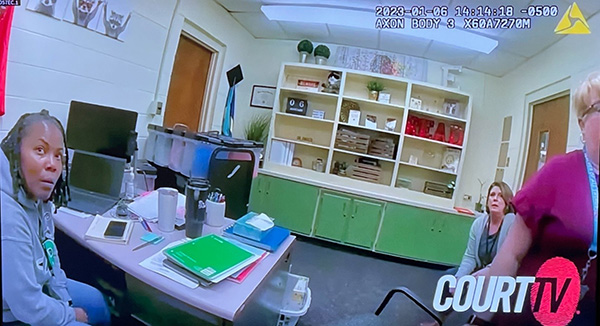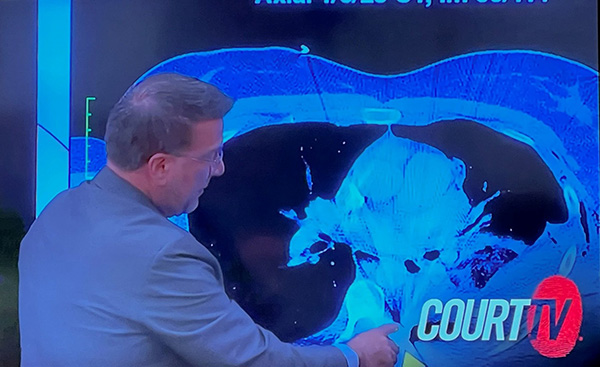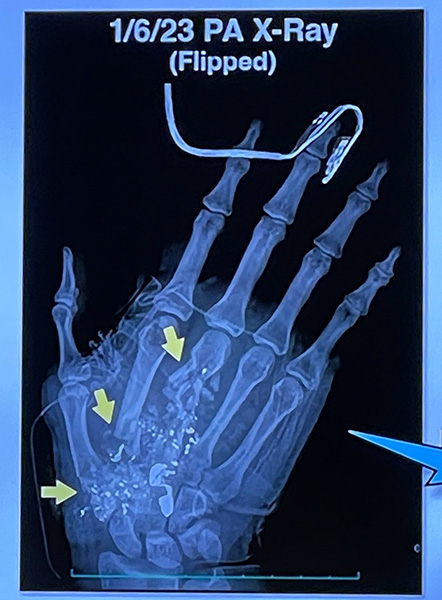See here a report on the first day of the trial.
On October 29, the second day of the civil trial Zwerner vs. Parker, first responders gave testimony about the day that Abby Zwerner, a first-grade teacher in Newport News, Virginia, was shot by a six-year-old student. An expert on education also testified about how Ebony Parker, the assistant principal of the school, put Miss Zwerner and everyone in the school in danger by failing to respond to information that the child might have a gun.
Corporal Thomas Blythe, Newport News Police Department
Cpl. Blythe found the school doors locked when he responded to a 911 call, but a janitor let him inside. He looked into the main office — that of Dr. Parker — and saw people tending to a woman lying on the floor. Looking for the shooter, he passed a janitor in the hallway, who said, “We have him.” Cpl. Blythe then went into Classroom 11.

Bodycam image showing Ebony Parker (left) in her office.
“I stepped in the door and there was a young child being restrained by a woman, who I later found out was Amy Kovac, the reading teacher,” the officer testified. “We were quite taken aback; we didn’t expect to see so young a suspect. She said that she had control of him, that the gun was in the back of the classroom and pointed that way. I immediately headed in that direction. When I found the weapon on the floor, I called out that there was a gun, and I stood by.”
Cpl. Blythe made sure the crime scene was undisturbed.

Bodycam image showing gun on classroom floor.
Defense attorney Daniel Hogan showed Cpl. Blythe’s bodycam footage from the moment he stepped into Dr. Parker’s office. Mr. Hogan pointed out that Dr. Parker’s desk was facing away from the door and that she had to turn around to see anyone who came in. In the previous day’s testimony, it had been mentioned that Dr. Parker did not look up and acknowledge Miss Zwerner when she came in to report on behavior problems that “JT” — the boy who would later shoot her — was having that morning.
Dr. Ann Shufflebarger, expert witness for plaintiff
Dr. Ann Shufflebarger has a Doctor of Education degree and has held jobs like those of many others in this case. She was hired by the plaintiff’s team to review materials about the incident and give her expert opinion on whether Dr. Parker had handled the situation properly.
On the stand, Dr. Shufflebarger said, “My finding is that Dr. Parker did not take action that I think an assistant principal should have taken at that time. . . . When an administrator receives a report of a suspected weapon. . . an administrator is to take it as a credible threat until you assess the situation and find otherwise.”
She said there were four separate times when Dr. Parker was notified that JT might be hiding a gun. “Hearing it the first time and not taking action — I don’t know what individuals were thinking,” Dr. Shufflebarger testified. “But when it comes back up again: ‘I checked the bookbag and it’s not there, but I’m getting reports that he has something in his pockets.’ That to me is a huge red flag. Take action. Get the kids secured. Call law enforcement. Alert the principal.”
The plaintiff’s attorney mentioned that none of the teachers called 911. Dr. Shufflebarger attributed that to the chain of command at the school. Teachers are taught to “report to an administrator,” and several teachers reported their suspicions to Dr. Parker.
Dr. Shufflebarger talked about how staff members asked to search JT, but Dr. Parker would not allow them to. “It’s almost shocking the lack of action there, how things were not followed up on. It really does breach the standard of care.”
The defense council asked Dr. Shufflebarger if, in her long career, she had ever had to deal with a first-grader bringing a gun to school. She admitted she had not. She also acknowledged that an assistant principal who is acting as a testing coordinator (as Dr. Parker had been doing that day) must abide by strict rules regarding standardized testing. However, Dr. Shufflebarger thought that should not have stood in Dr. Parker’s way when it came to the possibility that a child had a weapon. She said that Dr. Parker did not have to stay by her computer all day and that she was free to leave her office if she locked up the testing tickets.
“Being an administrator is a hard job. Absolutely, administrators wear lots of hats, and you have to handle things that happen quickly. You may have a plan — I’m going to do this today — and then you never get to it, because it’s almost like a triage situation. You have to determine. . . what is more urgent at this time. And a report of a firearm stops everything. You stop, you investigate, and you determine if it’s credible. And then you can move on with your day if it turns out not to be.”
The defense tried to discredit Dr. Shufflebarger’s testimony by getting her to agree that she had never served as an expert in court before, and that she had been paid $500 per hour to consult on the case.
Drs. Munn, Andersen, and Stuart, surgeons
Dr. Daniel Munn was one of the surgeons who treated Abby Zwerner after she was shot. He showed the jury a CAT scan and diagrams that showed how the bullet landed two centimeters from Miss Zwerner’s aorta. He told them, “There are several things about the way the bullet went in that are life threatening. . . . Any human being can bleed to death from that level of injury to the lung. Where this bullet ended up, it went past the heart and just barely missed it, and then also ended up within two centimeters of the biggest artery in the entire body. Patients would bleed to death in seconds from injury to that vessel.”

Dr. Munn pointing to an X-ray of plaintiff’s chest injuries
Miss Zwerner’s lung collapsed after she was shot, and Dr. Munn said that a collapsed lung “can oftentimes cause a patient to pass away at the scene of their injury.”
A tube was placed in Miss Zwerner’s chest to re-expand her lung, and this procedure created scar tissue inside her chest that will limit her doctors’ options if she needs any chest surgery in the future.
Because the bullet was so close to the aorta and spine, surgeons determined that it was too dangerous to attempt to remove it. Dr. Munn said that projectiles stuck in the body typically cause no harm, as long as they do not move. However, he added, “There are certainly events that could cause this bullet to move. If she was under a significant impact of some sort.”
He also said that having an inoperable bullet in her body means that Miss Zwerner will never be able to get an MRI. Magnetic Resonance Imaging is an important tool used to diagnose all kinds of medical conditions, including cancer.
Dr. Romney Andersen is an orthopedic surgeon who began treating Miss Zwerner the day after the shooting. He said she had a “devastating hand injury with a significant amount of bone fractures as well as a number of soft tissue injuries.”
Dr. Andersen said that on a scale of one to ten this was “a ten-type injury,” similar to injuries he had treated in war zones in Iraq and Afghanistan. He showed the jury X-rays of Miss Zwerner’s hand, which was filled with bullet fragments and pieces of her shattered bones.

X-ray of plaintiff’s hand injuries
Dr. Andersen described how damage to Miss Zwerner’s tendons and nerves would severely impact her use of her hand.
Dr. James Stuart is an orthopedic surgeon who took over Miss Zwerner’s care after the bone in her hand failed to heal properly. Cortisol injections gave her only moderate, short-term relief, and he concluded that Miss Zwerner needed surgery. In the operation, Dr. Stuart grafted bone from Miss Zwerner’s pelvis onto her hand. A plate and screw were used to stabilize the bone graft and help it to heal. At the time of the trial, the plate is still in Miss Zwerner’s hand and will need to be removed in six to eight months. She still has a lot of pain in that hand, and Dr. Stuart testified that the injuries to it are permanent.
As mentioned in the first day’s report, the defense has insinuated that Abby Zwerner’s having earned a cosmetology license since the shooting indicates that her injuries were not as severe as she has maintained. The illustrations and X-rays shown by Dr. Stuart suggest otherwise.
Hannah Zwerner, twin sister of the plaintiff
The final witness of the day was Abby Zwerner’s fraternal twin sister, Hannah, a high-school English teacher. The two shared a home, and Hannah Zwerner commented on her sister’s work habits: “Abby had mountains of paperwork. She would hook up to the printer and print lessons for the next day, and I just remember thinking, ‘She’s so dedicated.’ I never brought work home.”
When Abby did have spare time, she liked to shop or visit with friends. “She did not want to sit still; she always wanted to go out and do things.”
When asked how her sister had changed after the shooting, Hannah replied, “She’s just not the person that she was. . . . She’s lost her sense of direction. . . . She doesn’t want to go out anymore. I think she had a lot of be excited about, and she doesn’t anymore, and so that light has kind of dimmed. . . . It’s very hard to get her to go out and do things, and even if she does, someone has to be with her. She’s really afraid of being alone.”
The defense questioned this alleged reclusiveness, given that Abby Zwerner had gone “out into the community” with a GoFundMe page and another fundraiser that sold t-shirts. Hannah testified that it was she who had created those things, with her sister’s permission. The defense also mentioned that Abby had attended a Taylor Swift concert, to which Hannah replied, “I drained my bank account to take her to Taylor Swift. It was not without its own challenges.”
In tomorrow’s installment, Abby Zwerner takes the stand.
The post Zwerner vs. Parker, Day Two appeared first on American Renaissance.
American Renaissance




 R1
R1
 T1
T1


